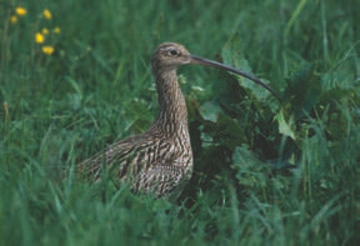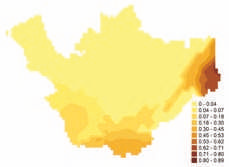
Curlew © Simon Booth
In the last century, the Curlew has waxed and waned as a breeding bird in the county, but is now definitely waning. Their breeding areas used to be only the eastern hills, but from about 1940 to 1965 they occupied much of southwest and central Cheshire as well. By the time of our First Atlas they may have been decreasing, and the ‘change’ map shows that, in the last twenty years, they have been lost from large parts of the county: almost all of Wirral; around Chester; much of the agricultural south of Cheshire; and many tetrads in the vicinity of Wilmslow and Congleton in the east. In terms of breeding season presence, there is a net loss from 91 tetrads. The picture is probably worse than that figure suggests, however, because almost half of the tetrads have only a small dot on the map (‘possible’ breeding) because the only evidence was one or more birds seen in potentially suitable habitat. In many instances there was no sign of the species later in the season – some of these will have been one-year-old birds, too young to breed – and observers felt sure that Curlews had not bred in the tetrad. The number of tetrads with confirmed or probable breeding is now only 67, a 55% drop from the figure of 149 in the First Atlas. Observers proved breeding in only 14 tetrads (a big fall from 61 twenty years ago) when birds with chicks were seen in ten tetrads, with adults performing distraction display in a further four. Probable breeding was recorded in 53 tetrads (down from 88) with 12 instances of birds showing agitated behaviour, 19 of display, and 22 tetrads with pairs present.

Curlew abundance.
The reasons for their decline across much of Cheshire probably lie in changes in agricultural practice, especially early cutting of grass for silage, and continued drainage. The habitat codes in the 67 tetrads with confirmed or probable breeding show the species’ dependence on farmland: 37 were recorded as E1 (improved grassland), 17 E2 (unimproved grassland) and six E3 (mixed grass/ tilled land), with six on grass moor and three on heath or bog. This is a higher proportion of records on unimproved grassland than any other species in the county.
Curlews were lost from much of lowland southern England between the national breeding atlases of 1968-72 and 1988-91, and surveys in England and Wales revealed a decrease of 39% in breeding birds in wet meadows between 1982 and 2002 (Wilson et al 2005). On the other hand, the breeding population of the South Pennines Moors SPA, of which the Cheshire moors are a part, showed a 31% rise between 1990 and 2004-05 (Eaton et al 2007). The analysis of Breeding Bird Survey transects shows that the Curlew breeding population in Cheshire and Wirral during 2004-05 was 180 birds (with a wide confidence range of zero to 420), a considerable drop from the estimate in our First Atlas of 250-350 pairs. The abundance map shows that the highest densities of Curlew are in the eastern hills.
Sponsored by Peter Mathews

